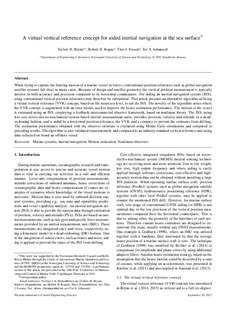| dc.contributor.author | Bryne, Torleiv Håland | |
| dc.contributor.author | Rogne, Robert Harald | |
| dc.contributor.author | Fossen, Thor I. | |
| dc.contributor.author | Johansen, Tor Arne | |
| dc.date.accessioned | 2017-11-02T08:03:13Z | |
| dc.date.available | 2017-11-02T08:03:13Z | |
| dc.date.created | 2017-11-01T11:59:13Z | |
| dc.date.issued | 2017 | |
| dc.identifier.citation | Control Engineering Practice. 2017, 70 1-14. | nb_NO |
| dc.identifier.issn | 0967-0661 | |
| dc.identifier.uri | http://hdl.handle.net/11250/2463586 | |
| dc.description.abstract | When trying to capture the heaving motion of a marine vessel in waves, conventional position references such as global navigation satellite systems fall short in many cases. Because of design and satellite geometry, the vertical position measurement is typically inferior in both accuracy and precision compared to its horizontal counterparts. For aiding an inertial navigation system (INS), using conventional vertical position references may therefore be suboptimal. This article presents an alternative algorithm utilizing a virtual vertical reference (VVR) concept, based on the mean sea level, to aid the INS. The novelty of the algorithm arises where the VVR concept is augmented with an error model, used to improve the heave estimation performance. The motion of the vessel is estimated using an INS, employing a feedback-interconnected observer framework, based on nonlinear theory. The INS, using low-cost micro-electro-mechanical-system-based inertial measurement units, provides position, velocity and attitude in a dead-reckoning fashion, and is aided by a horizontal position reference, the VVR, and a compass to prevent the estimates from drifting. The estimation performance obtained with the observer structure is evaluated using Monte Carlo simulations and compared to preceding results. The algorithm is also validated experimentally and compared to an industry standard vertical reference unit using data collected on board an offshore vessel. | nb_NO |
| dc.language.iso | eng | nb_NO |
| dc.publisher | Elsevier | nb_NO |
| dc.rights | Attribution-NonCommercial-NoDerivatives 4.0 Internasjonal | * |
| dc.rights.uri | http://creativecommons.org/licenses/by-nc-nd/4.0/deed.no | * |
| dc.title | A virtual vertical reference concept for aided inertial navigation at the sea surface | nb_NO |
| dc.type | Journal article | nb_NO |
| dc.type | Peer reviewed | nb_NO |
| dc.description.version | acceptedVersion | nb_NO |
| dc.source.pagenumber | 1-14 | nb_NO |
| dc.source.volume | 70 | nb_NO |
| dc.source.journal | Control Engineering Practice | nb_NO |
| dc.identifier.doi | 10.1016/j.conengprac.2017.09.009 | |
| dc.identifier.cristin | 1509704 | |
| dc.relation.project | Norges forskningsråd: 225259 | nb_NO |
| dc.relation.project | Norges forskningsråd: 223254 | nb_NO |
| dc.description.localcode | © 2017. This is the authors’ accepted and refereed manuscript to the article. LOCKED until 16.10.2018 due to copyright restrictions. This manuscript version is made available under the CC-BY-NC-ND 4.0 license http://creativecommons.org/licenses/by-nc-nd/4.0/ | nb_NO |
| cristin.unitcode | 194,63,25,0 | |
| cristin.unitname | Institutt for teknisk kybernetikk | |
| cristin.ispublished | true | |
| cristin.fulltext | postprint | |
| cristin.qualitycode | 1 | |

